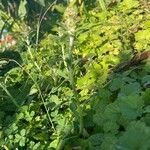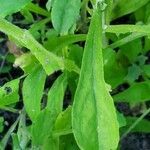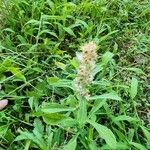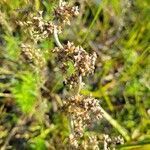Herbs, annual or biennial. Stems erect to decumbent-ascending, unbranched or 1 or 2 branched from base, 10-40 cm tall, densely but loosely pannose or pannose-tomentose. Leaves basal and cauline, basal and proximal cauline in rosettes, withered but persistent at anthesis; blades oblanceolate to spatulate, 1-6 cm × 5-14 mm, upper ones smaller, both surfaces usually bicolored, abaxially closely white pannose, adaxially usually sparsely arachnoid (basal cells of hairs persistent, expanded, glassy), sometimes glabrescent. Capitula initially in continuous spiciform arrays 1-4(-5) cm × (5-)10-15 mm, later interrupted, glomerules widely separated, bracteate, proximal often on relatively long peduncles. Involucre turbinate-cylindric, 3-4.5 mm, base sparsely arachnoid; phyllaries 4-or 5-seriate, outer ovate-triangular, length 1/3-2/3 of inner, apices acute-acuminate; inner triangular-lanceolate (usually striate), laminae purplish (in bud) to whitish or silvery (in fruit), apices acute (not apiculate). Bisexual florets 3 or 4. Corollas of all florets usually purplish distally. Achenes oblong, 0.6-0.7 mm. Pappus connate into a ring, ca. 2.5 mm. Fl. Apr-May. 2n = 14, 28.
Annuals (sometimes winter annuals), 10–40(–50) cm; fibrous-rooted or taprooted. Stems erect to decumbent-ascending, densely but loosely pannose or pannose-tomentose. Leaves basal and cauline, basal and proximal cauline usually withering before flowering; blades oblanceolate to spatulate, 1–6 cm × 5–14 mm (distal similar, at least among proximal heads, margins sometimes sinuate), faces usually bicolor, abaxial closely white-pannose, adaxial usually sparsely arachnose (basal cells of hairs persistent, expanded, glassy), sometimes glabrescent. Heads initially in continuous spiciform arrays 1–4(–5) cm × (5–)10–15 mm, later interrupted (glomerules widely separated, bracteate, the proximal often on relatively long peduncles). Involucres turbinate-cylindric, 4–4.5 mm, bases sparsely arachnose. Phyllaries in 4–5 series, outer ovate-triangular, lengths 1/3–2/3 inner, apices acute-acuminate, inner triangular-lanceolate (usually striate), laminae purplish (in bud) to whitish or silvery (in fruit), apices acute (not apiculate). Florets: bisexual 3–4; all corollas usually purplish distally. Cypselae (tan) 0.6–0.7 mm. 2n = 14, 28.
A herb. It can grow from seed each year or keep growing from year to year. It grows 10-40 cm tall. The leaves at the base are in rings. They are 1-6 cm long by 1 cm wide. The higher leaves are smaller. They are whitish underneath.






